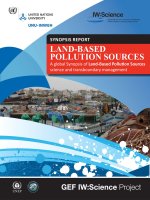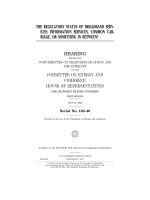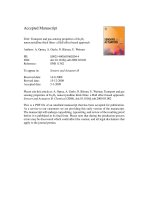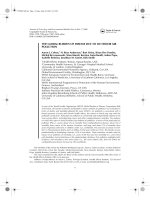Global Status of Commercialized Biotech/GM Crops: 2004
Bạn đang xem bản rút gọn của tài liệu. Xem và tải ngay bản đầy đủ của tài liệu tại đây (643.65 KB, 12 trang )
I S A A A
I
NTERNATIONAL
S
ERVICE
FOR
THE
A
CQUISITION
OF
A
GRI
-
BIOTECH
A
PPLICATIONS
EXECUTIVE SUMMAREXECUTIVE SUMMAR
EXECUTIVE SUMMAREXECUTIVE SUMMAR
EXECUTIVE SUMMAR
YY
YY
Y
No. 32 - 2004
PREVIEW
Global Status of Commercialized Biotech/GM Crops: 2004
by
Clive James
Chair, ISAAA Board of Directors
Source: Clive James, 2004
1995
1996 1997 1998 1999 2000
10
20
30
40
50
60
70
0
2001
2002
2003 2004
80
90
Total
Industrial Countries
Developing Countries
17 Biotech Crop Countries
Increase of 20%, 13.3 million hectares or 32.9 million acres between 2003 and 2004.
GLOBAL AREA OF BIOTECH CROPS
Million Hectares (1996 to 2004)
Cosponsors:
Published by:
Copyright:
Citation:
ISBN:
Publication Orders:
Info on ISAAA:
Electronically:
Price:
ISAAA
Fondazione Bussolera Branca, Italy
The Rockefeller Foundation, USA
ISAAA gratefully acknowledges grants from Fondazione Bussolera Branca and the Rockefeller
Foundation to support the preparation of this Review and its free distribution to developing countries.
The objective is to provide information and knowledge to the scientific community and society re
biotech/GM crops to facilitate a more informed and transparent discussion re their potential role in
contributing to global food, feed and fiber security, and a more sustainable agriculture. The author,
not the cosponsors, takes full responsibility for the views expressed in this publication and for any
errors of omission or misinterpretation.
The International Service for the Acquisition of Agri-biotech Applications (ISAAA).
(2004) International Service for the Acquisition of Agri-biotech Applications (ISAAA).
Reproduction of this publication for educational or other non-commercial purposes is authorized
without prior permission from the copyright holder, provided the source is properly acknowledged.
Reproduction for resale or other commercial purposes is prohibited without the prior written
permission from the copyright holder.
James, C. 2004. Preview: Global Status of Commercialized Biotech/GM Crops: 2004. ISAAA Briefs
No. 32. ISAAA: Ithaca, NY.
1-892456-36-2
Please contact the ISAAA SEAsiaCenter or email to
ISAAA SEAsiaCenter
c/o IRRI
DAPO Box 7777
Metro Manila, Philippines
For information about ISAAA, please contact the Center nearest you:
ISAAA AmeriCenter ISAAA AfriCenter ISAAA SEAsiaCenter
417 Bradfield Hall c/o CIP c/o IRRI
Cornell University PO 25171 DAPO Box 7777
Ithaca NY 14853, U.S.A. Nairobi Metro Manila
Kenya Philippines
or email to
For Executive Summaries of all ISAAA Briefs, please visit www.isaaa.org
US$ 35, including airmail postage and the full version of Briefs No. 32 when published.
Available free of charge to nationals of developing countries.
GLOBAL STATUS OF COMMERCIALIZED BIOTECH/GM CROPS: 2004
Global Status of Biotech Crops in 2004
• 2004 is the penultimate year of the first decade of the commercialization of genetically modified
(GM) or transgenic crops, now often called biotech crops, as referred to consistently in this Brief. In
2004, the global area of biotech crops continued to grow for the ninth consecutive year at a
sustained double-digit growth rate of 20%, compared with 15% in 2003. The estimated global area
of approved biotech crops for 2004 was 81.0 million hectares, equivalent to 200 million acres, up
from 67.7 million hectares or 167 million acres in 2003. Biotech crops were grown by approximately
8.25 million farmers in 17 countries in 2004, up from 7 million farmers in 18 countries in 2003.
Notably, 90% of the beneficiary farmers were resource-poor farmers from developing countries,
whose increased incomes from biotech crops contributed to the alleviation of poverty. The increase
in biotech crop area between 2003 and 2004, of 13.3 million hectares or 32.9 million acres, is the
second highest on record. In 2004, there were fourteen biotech mega-countries (compared with ten
in 2003), growing 50,000 hectares or more, 9 developing countries and 5 industrial countries; they
were, in order of hectarage, USA, Argentina, Canada, Brazil, China, Paraguay, India, South Africa,
Uruguay, Australia, Romania, Mexico, Spain and the Philippines. During the period 1996-2004,
the accumulated global biotech crop area was 385 million hectares or 951 million acres, equivalent
to 40% of the total land area of the USA or China, or 15 times the total land area of the UK. The
continuing rapid adoption of biotech crops reflects the substantial improvements in productivity,
the environment, economics, health and social benefits realized by both large and small farmers,
consumers and society in both industrial and developing countries.
PREVIEW: Global Status of Commercialized Biotech/GM Crops: 2004
3
Source: Clive James, 2004
1995
1996 1997 1998 1999 2000
10
20
30
40
50
60
70
0
2001
2002
2003 2004
80
90
Total
Industrial Countries
Developing Countries
Increase of 20%, 13.3 million hectares or 32.9 million acres between 2003 and 2004.
GLOBAL AREA OF BIOTECH CROPS
Million Hectares (1996 to 2004)
• During the nine-year period 1996 to 2004, global area of biotech crops increased more than
47 fold, from 1.7 million hectares in 1996 to 81.0 million hectares in 2004, with an increasing
proportion grown by developing countries. More than one-third (34%) of the global biotech
crop area of 81 million hectares in 2004, equivalent to 27.6 million hectares, was grown in
developing countries where growth continued to be strong. It is noteworthy that the absolute
growth in biotech crop area between 2003 and 2004 was, for the first time, higher for developing
countries (7.2 million hectares) than for industrial countries (6.1 million hectares), with the
percentage growth almost three times as high (35%) in the developing countries of the South,
compared with the industrial countries of the North (13%). The increased hectarage and impact
of the five principal developing countries* (China, India, Argentina, Brazil and South Africa)
growing biotech crops is an important trend with implications for the future adoption and
acceptance of biotech crops worldwide; see full Brief for biotech crop overviews for each of
the five countries. In 2004, the number of developing countries growing biotech crops (11) was
almost double the number of industrial countries (6) adopting biotech crops.
Biotech Crop Area by Country, Crop and Trait
• Countries that grow 50,000 hectares, or more, of biotech crops are classified as biotech mega-
countries. In 2004, there were 14 mega-countries, compared with 10 in 2003, with Paraguay,
Spain, Mexico and the Philippines joining the mega-country group for the first time in 2004.
This 40% increase in the number of mega-countries reflects a more balanced and stabilized
participation of a broader group of countries adopting biotech crops. The 14 mega-countries,
in descending order of hectarage of biotech crops, were: USA with 47.6 million hectares (59%
of global total), followed by Argentina with 16.2 million hectares (20%), Canada 5.4 million
hectares (6%), Brazil 5.0 million hectares (6%), China 3.7 million hectares (5%), Paraguay
with 1.2 million hectares (2%) reporting biotech crops for the first time in 2004, India 0.5
million hectares ((1%), South Africa 0.5 million hectares (1%), Uruguay 0.3 million hectares
(<1%), Australia 0.2 million hectares (<1%), Romania 0.1 million hectares (<1%), Mexico 0.1
million hectares (<1%), Spain 0.1 million hectares (<1%), and the Philippines 0.1 million
hectares (<1%).
• Based on annual percentage growth in area, of the eight leading biotech crop countries, India
had the highest percentage year-on-year growth in 2004 with an increase of 400% in Bt cotton
area over 2003, followed by Uruguay (200%), Australia (100%), Brazil (66%), China (32%),
South Africa (25%), Canada (23%) Argentina (17%) and the USA at 11%. In 2004, India increased
its area of approved Bt cotton, introduced only two years ago, from approximately 100,000
hectares in 2003 to 500,000 hectares in 2004 when approximately 300,000 small farmers
PREVIEW: Global Status of Commercialized Biotech/GM Crops: 2004
4
* Highlighted in this Executive Summary in 5 boxes with photos
benefited from Bt cotton. Whereas growth in Uruguay in 2004 was accentuated by a conservative
2003 adoption rate, biotech soybean now occupies >99 % of the total soybean area in Uruguay,
plus a significant increase in biotech maize taking the total biotech crop area above 300,000
hectares. After suffering severe drought for the last two years, Australia increased its total cotton
plantings to about 310,000 hectares of which 80%, equivalent to 250,000 hectares, were planted
with biotech cotton in 2004. Brazil increased its biotech soybean area by two-thirds from 3
million hectares in 2003 to a projected conservative 5 million hectares in 2004, with another
significant increase likely in 2005. China increased its Bt cotton area for the seventh consecutive
year; an increase of one-third from 2.8 million hectares in 2003 to 3.7 million hectares in
2004, equivalent to 66% of the total cotton area of 5.6 million hectares in 2004, the largest
national cotton hectarage planted in China since the introduction of Bt cotton in 1997. South
Africa reported a 25% increase in its combined area of biotech maize, soybean and cotton to
PREVIEW: Global Status of Commercialized Biotech/GM Crops: 2004
5
Biotech Crop Countries and Mega-Countries*, 2004
#13
Spain*
0.1 Million Has.
Maize
#11
Romania*
0.1 Million Has.
Soybean
#7
India*
0.5 Million Has.
Cotton
#17
Germany
<0.05 Million Has.
Maize
#3
Canada*
5.4 Million Has.
Canola, Maize, Soybean
#5
China*
3.7 Million Has.
Cotton
#14
Philippines*
0.1 Million Has.
Maize
#10
Australia*
0.2 Million Has.
Cotton
#1
USA*
47.6 Million Has.
Soybean, Maize, Cotton,
Canola
#12
Mexico*
0.1 Million Has.
Cotton, Soybean
#16
Honduras
<0.05 Million Has.
Maize
#15
Colombia
<0.05 Million Has.
Cotton
#2
Argentina*
16.2 Million Has.
Soybean, Maize, Cotton
#9
Uruguay*
0.3 Million Has.
Soybean, Maize
#6
Paraguay*
1.2 Million Has.
Soybean
#4
Brazil*
5.0 Million Has.
Soybean
#8
South Africa*
0.5 Million Has.
Maize, Soybean, Cotton
*14 biotech mega-countries growing 50,000 hectares, or more, of biotech crops.
Source: Clive James, 2004









